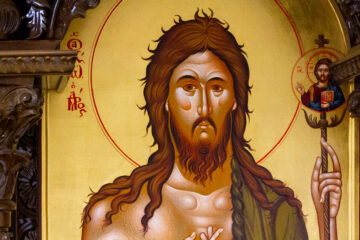Presvytera Mallory Kasapakis shows us how to keep the joy of Pascha alive in our hearts by celebrating the Bright Week that follows and maintaining our spiritual connection to the church through specific activities and traditions.
As Great Lent and Holy Week ends, the exhaustion of the Lenten season has turned into the excitement of Pascha. But what happens in the weeks that follow? Many of us are so burnt out that we decide to sleep-in the next Sunday and play hooky from church. We may become lax in our daily prayer routines or even turn our focus to planning our summer travels. Others decide to “check out” from church until the start of a new ministry year.
You may be tempted to say, “I’m so tired. I need a break.” But on the contrary, the next 40 days after Pascha are crucial for us as Christians. We have spent weeks preparing our hearts to receive the news of the glorious resurrection. The feelings after the Anastasi service are sometimes described as “inexplicable” and “child-like joy.” We have gained a new life and celebrate that reality with a joy that is so great that it is celebrated for another 40 days. Now is the time to ensure that our spiritual life continues to be nourished so that we can do our work and spread the good news to the world.
So how do we keep the momentum going? First, take a deep breath. The easiest (and most challenging) way is to simply continue on the path to salvation. Keep attending the Divine Liturgy. Receive Holy Communion frequently. Remain vigilant in your prayer life and active in your churches. During Bright Week there are specific feast days that are strategically placed to help us celebrate this new light. On Bright Friday, the Church commemorates The Mother of God of the Life-giving Spring (or Font), and depending on how the calendar falls, Saint George is commemorated on Bright Monday and Sts. Raphael, Nicholas, and Irene on Bright Tuesday.
Saint Porphyrios, the wonderworker of Kafsokalyvia, writes in Wounded by Love:
There was no question of laziness. I liked to pray even when I was tired. When I was exhausted, I sought God even more. You must believe this and realize that it’s truly possible. It’s a matter of love. It’s not simply that you work quickly. You do one job, then you begin another, you come back and do yet another, and you ensure you finish them all. With love, you are in perpetual motion. You should see, then, where sins go. They all fall into a deep sleep. Do you hear? This is truly a life lost from the world, a blessed and holy life, a life in Paradise.
We can continue the excitement of Pascha and the momentum toward the heavenly kingdom by bringing the church into our homes. Liturgical living at home is, more than anything, a lifestyle, a way of living and practicing our faith in the modern world. This lifestyle does not need to be Pinterest-worthy or photographed on social media; it is meant to be purposeful and practical. The church is filled with many traditions; they are tools that connect us every day back to our faith. There are big “T” traditions, which are more formal and passed down by our church fathers; there are small “t” traditions, which are passed down by generations of cultures; and there are things that we do simply because yiayia said so. The only rule is to create traditions that keep your life focused on Christ.
Here are a few ways our family has celebrated Bright Week and the Paschal season at home:
- Keep the Paschal light ablaze. Many of us have carefully carried home our candles from the Anastasi service, protecting the precious light from the elements to bring the light of Christ into our homes. It is always fun to see the creative ways parishioners nurture their lights; during our Holy Friday retreat the youth spend some time decorating little lanterns for them to safely transport the flame home. When you get home, don’t forget to use the smoke of the Holy Light candle to make the sign of the cross over your front door to bring the Paschal blessings inside the home. This is a small “t” tradition of our church and you will see this marking in many Greek homes.
- Brighten with Light. Leave a light on in the room where your icons are displayed. This will serve as a visual reminder in your own home, just like those we see in church during the Paschal season. There are visual reminders of these continuous Pascha celebrations seen in our churches with festive banners, the Lord’s Burial Shroud, the tomb from Holy Friday displayed with beautiful flowers, and the royal doors that remain open leading up to the Sunday of Thomas.
- Enjoy a Fast-Free Week. Immediately after the Anastasi service, we focus on the greatest and most important feast, the celebratory “Feast of Feasts.” To remain in this state of rejoicing, we do not abstain from any foods. It is a fast-free week, so make it fun for the family: make reservations at a fancy steak house, have ice cream sundaes for dinner, or have a BBQ in the park on Friday.
- Brighten up your wardrobe and home. Wear white and bright colors to celebrate—white is the color of new life—a new life in Christ! Bring bright decorations into your home, such as a festive tablecloth or throw pillows. Remember you do not need to buy anything new—you can bring something into the living space from another room. Display or print an icon of the Resurrection and place it somewhere for everyone to see, like the dining room table or on top of a mantel.
- Start a new Bible study or read a spiritual book. This is a time of great spiritual rebirth and an opportunity to dive into the scriptures. The OCN website has an abundance of recorded Bible studies on various topics. Click here for more ideas.
- Plant a garden. Use this time as an opportunity to connect with Creation and the Creator. Jesus’ victory over death is evident in the trees and flowers that reemerge each spring, and planting seeds reminds us of the new life to come. Let us all celebrate Christ’s promise of eternal life and a more abundant life here on earth.
Christ is Risen! Truly he is Risen!



0 Comments